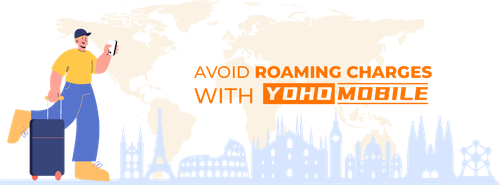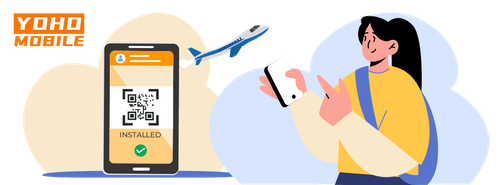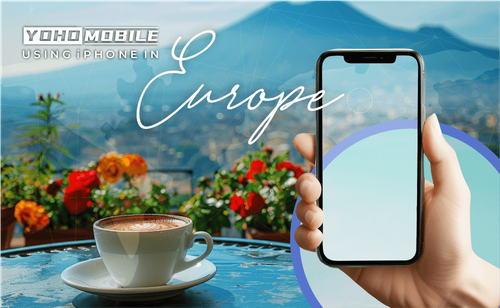If you are planning to travel to Europe and you belong to the 28% of the population that uses iPhones, we have prepared a small guide for you. It will help you to know everything about using an iPhone in Europe, including its compatibility with European networks, how to set it up, and how to establish an internet connection.
How To Prepare Your iPhone for International Travel?
To prepare your iPhone for international travel, especially in Europe, several key steps can enhance your experience.
How to Know If Your iPhone is Locked or Unlocked?
The first thing is to check if your iPhone is locked or unlocked. What does this mean? It is if your iPhone can use any carrier without problems. On an unlocked iPhone, you can install any eSIM card.
- Tip 1: If you are not sure if your iPhone is locked or unlocked, you can go to Settings > General > About > Carrier Lock (or Network Provider Lock). If it says “No SIM restrictions”, this means that your smartphone is unlocked and has no restrictions. If your iPhone is locked, you’ll see the name of your carrier.
- Tip 2: Apple sells phones that are already factory unlocked. But if your phone was purchased through a carrier such as AT&T or Verizon, it is most likely locked.
If you want to travel to Europe with a locked iPhone, you can call your carrier to unlock your smartphone or buy an international data package for Europe. With this Europe plan, you will be able to make calls, surf the web, and send SMS, but it would be more expensive. We do not suggest traveling without a data plan because you would need to use public WiFi networks, which would put your personal information at risk. In that case, it’s highly recommended to use a VPN to have a more secure connection.
The best alternative would be to travel with an unlocked iPhone as you will be able to use eSIM to connect to the Internet without any worries. You can purchase a Europe data plan from the top eSIM providers; Yoho Mobile is a recommended option.
Understand Your iPhone’s Compatibility with European Networks
The second thing to keep in mind is your iPhone’s compatibility with European networks. iPhones are designed to support various network technologies, including GSM, which is the standard network in Europe. However, to ensure that your iPhone will work properly, check your specific model and compatible frequency bands before your trip.
How to Use Your iPhone in Europe Without Roaming Charges?
The best solution for iPhone users is to get an eSIM or a local SIM card to avoid roaming charges in Europe. An eSIM is the best option, with more affordable rates and 100% digital features that will allow you to connect to the internet when traveling abroad. You can get an eSIM package from a top provider like Yoho Mobile that is easy to use, has no roaming charges, and has coverage throughout Europe.
You Might Also Like: Explore and Compare the Best eSIM Providers for Europe

Image by Vecteezy
What is an eSIM and How Can It Benefit You?
An eSIM is a digital SIM card pre-installed on your smartphone. It allows you to activate a new data plan on your phone with a simple download from your carrier. Using an eSIM is the best option to stay connected while traveling because it avoids the hassle of changing physical SIM cards. In addition, eSIMs come in various options—local, regional, or global—making them flexible for your travel needs. They’re user-friendly, with an included manual for easy installation and use.
If you want to know more about the advantages that eSIMs can offer you, check out “What is an eSIM for iPhone.”
A Quick Guide to Set Up an eSIM or your iPhone
Before activating your eSIM, ensure your device is eSIM-compatible and carrier-unlocked. Check out if your iPhone supports eSIM. It is also advisable to have the QR code printed out or on another device and have a stable internet connection to make the process smoother.
Once you are sure of all the above, follow the next steps:
Step 1: Install the eSIM by following the on-screen instructions on your device. Install your eSIM a day before your trip and activate it during your flight or upon arrival.
- You install your eSIM with the QR code or manually if you do not have the QR code.
- Select the device on which you are going to install an eSIM (iPhone) and follow the instructions for each device. If you have problems during the process, please contact the support team.
Step 2: Activate the eSIM: Once installed, activate the eSIM in your phone’s settings.
Step 3: Enjoy staying connected throughout Europe.
This is only a brief guide to installing and activating your eSIM. It is recommended to read an iPhone guide for a better understanding.

Image by Vecteezy
How to Choose the Best Data Plan for Your Trip to Europe
Choosing the best data plan for Europe depends a lot on your needs and your travel plans. Overall, Yoho Mobile is a wise choice, with affordable plans, a variety of data packages covering 31 European countries, and a reliable customer support team.
Check out this comprehensive article on the best eSIM providers in Europe — it has a handy comparison chart to help you understand all of the options easily.
Fixing The Most Common Connectivity Issues in iPhone
- Slow Internet: Use a network monitoring tool to identify and resolve speed issues.
- Connection Drops: Check physical connections, test network stability with ping or traceroute, and improve Wi-Fi signal strength. Solutions may involve replacing hardware, adjusting router position, or contacting your ISP.
- WiFi Blackspots: Centralize your router and adjust the antenna for better coverage.
- Bandwidth and Network Usage: Upgrade bandwidth, clear browser cache, or use a VPN for faster data transfer.
User Experiences: Tips for European Travelers
- Check Compatibility: Ensure your smartphone supports eSIM.
- Research Plans: Compare eSIM plans for coverage and budget.
- Read Reviews: Evaluate eSIM providers based on customer feedback.
- Understand Activation: Know how to activate your eSIM before traveling.
- Monitor Data Usage: Use eSIM apps to track data and avoid overages.
- Keep a Backup: Carry a physical SIM card as a backup.
FAQs About Using Your iPhone in Europe
Will my phone work in Europe?
Most newer phones are compatible with European networks, but if you are unsure, check with your carrier. In addition, check your carrier’s international rates.
Should data roaming be on or off in Europe?
In Europe, whether to enable or disable data roaming depends on your needs. Turn on data roaming to access internet services abroad through your carrier. Turn it off when not using data to avoid unexpected charges from connecting to foreign networks. Adjust this setting based on your usage to manage costs effectively during your trip.
Read more about How to Avoid Roaming Charges Overseas.
How to use your iPhone in Europe without a SIM card?
Using an iPhone without a SIM card means you won’t have cellular service for calls, texts, or mobile data. It’ll function like an iPod Touch or Wi-Fi device. However, you can still connect to Wi-Fi networks for internet access, use apps like iMessage and FaceTime, and download content from the App Store.
Certain features and apps may require a cellular connection, limiting functionality without a SIM card. When setting up a new iPhone, you typically need a SIM card for activation, but alternatives like using iTunes or borrowing a friend’s SIM during setup are possible. Emergency calls (e.g., 911 in the US) can still be made if there’s a cellular signal available. Additionally, iCloud services such as iCloud Drive, Photos, and Find My iPhone remain accessible without a SIM card. While using an iPhone without a SIM card is feasible, consider the limitations in cellular connectivity and functionality that may affect your usage.

